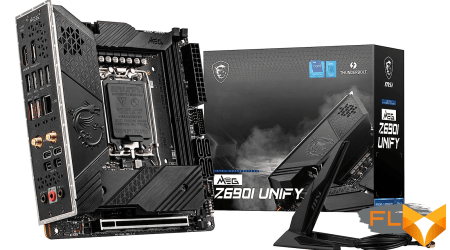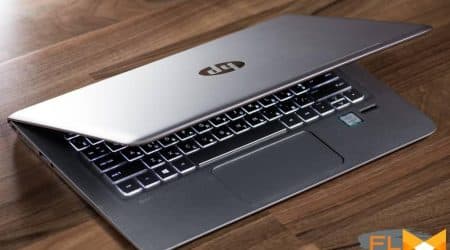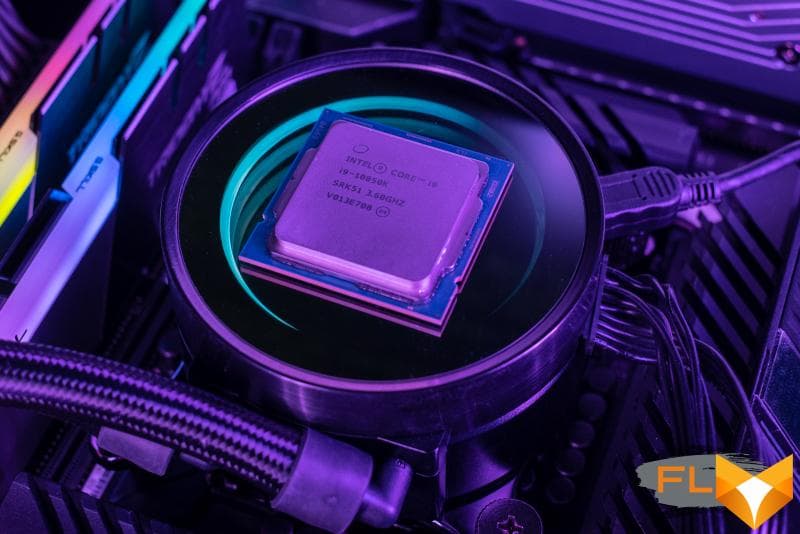


Modern Intel® Core™ desktop processors are traditionally divided into two groups: “regular” and “enthusiast”. And although real buyers are not always guided by this positioning, it describes well what you can expect from a particular chip.
The processors that Intel focuses on ordinary users are less expensive, but they are slower and more economical. These processors are designed to cause minimal problems for end users: they usually do not require any special system setup and are plug and play. In addition to the fact that such CPUs do not provide access to changing the multiplier, they also have more restrained frequencies and low consumption, which allows them to be equipped with relatively simple cooling systems and not bother with the selection of boards and other bindings.
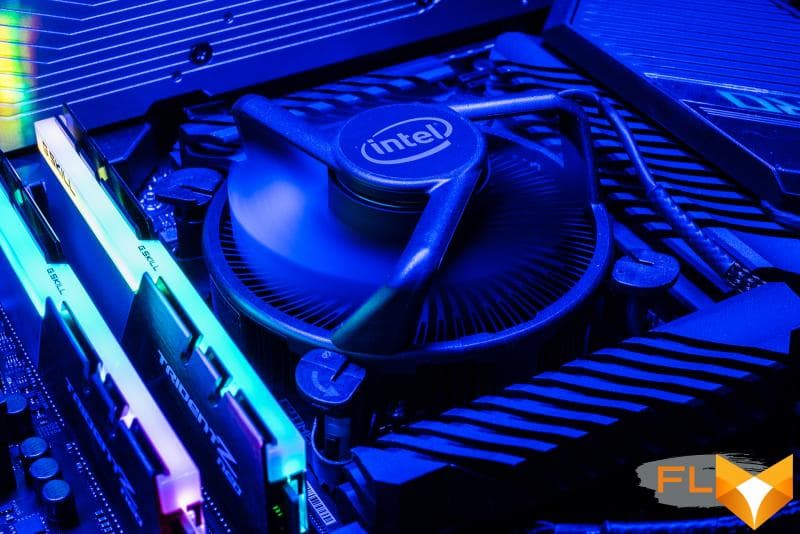
Surprisingly, processors belonging to different groups often have almost the same model numbers, although it is obvious that their performance and other consumer qualities can vary greatly. And this was especially evident in the Comet Lake generation. In it, overclocker CPU models noticeably increased their energy appetites and received a characteristic of typical heat dissipation at the level of 125 W. Processors for conventional systems continued to exist within the typical thermal package of 65 W for this class, that is, their consumption and heat dissipation turned out to be almost half that of their overclocking counterparts. And still, along with the Core i9-10900K, there is the Core i9-10900, next to the Core i7-10700K, the Core i7-10700 is installed, and instead of the Core i5-10600K, you can purchase the Core i5-10600.
The coexistence, on the one hand, of similar, but on the other hand, completely different models prompted us to think about the need to conduct special testing, which could show how big the difference between them is and how one should generally treat such a filling of the lineup of Core 10th processors. generations. This interest is largely fueled by the fact that “simple” models do not seem useless even for advanced users. On the one hand, they are 10-20% cheaper, but at the same time they offer exactly the same number of cores and threads as the flagship overclocker models. On the other hand, their base clock frequencies are lower by a whole gigahertz, which will certainly make an inexperienced user a frightening impression.
But even if significant differences in nominal frequencies do have real weight, this is not a reason to deliberately put an end to “non-K” models. Firstly, a quite positive message for a significant part of users can be carried by their efficiency immediately indicated in the specifications. Secondly, if you look at the maximum turbo frequencies of “regular” models, then the situation with the base frequencies ceases to seem so terrible, because according to this characteristic, the advantage of overclocker modifications with a TDP of 125 W is only 100-300 MHz.
In this article, we will try to give a clear answer to the question of what those who choose a processor without the “K” index in the name will have to face for their system: either with a multi-core CPU with not the most impressive performance, where energy efficiency is at the forefront, then whether with a cheaper and only slightly slower version of the flagship, or even with something in between. As part of a partnership project, Intel provided us with a detailed study of the Core i7-10700 processor, a promising eight-core processor that attracts with an official price of $323.
⇡#Core i7-10700 in detail
When talking about the Core i7-10700, we’re assuming you’re familiar with Intel’s flagship octa-core LGA1200 processor, the Core i7-10700K. If this is not the case, we strongly recommend that you refer to the corresponding review on our website.
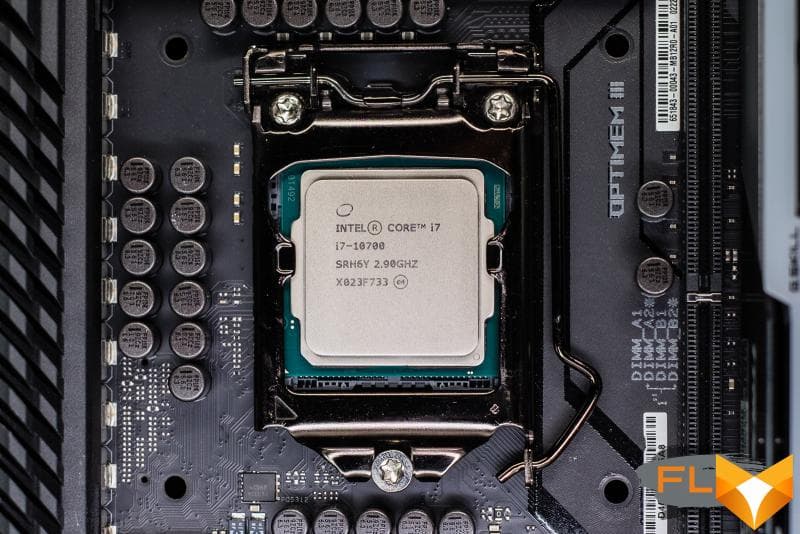
The fact is that if we discard all the overclocking features, then the Core i7-10700 without the K index turns out to be a very close relative of its overclocking counterpart. At least both of them are based on the same silicon, which means that the differences between them really exist only at the level of clock frequencies, as well as thermal and energy characteristics. In general, the Core i7-10700 is an eight-core processor based on the Skylake microarchitecture with support for Hyper-Threading technology, which has a 16 MB L3 cache. It is built on a Q0 stepping semiconductor chip, which is manufactured using a 14-nm process technology (with a certain number of plus signs) and initially has 10 cores, a couple of which are hardware-locked and inoperable. At the same time, the key property of the Core i7-10700 is efficiency: its thermal package is twice as strict as that of the Core i7-10700K, and the target heat dissipation is set to 65 watts.

Speaking of the Core i7-10700K, we drew close parallels between it and the previous generation octa-core Core i9-9900K. Following this logic further, I would like to say that the Core i7-10700 is the ideological successor of the 65-watt Core i9-9900, and this is almost true. However, there is one oddity: while the overclocker Core i7-10700K slightly outperforms the Core i9-9900K in terms of operating frequencies, the regular Core i7-10700, on the contrary, is slightly inferior to its predecessor for the LGA1151v2 platform.
How significant these differences can be estimated from the following table:
| Core i7-10700K | Core i7-10700 | Core i9-9900K | Core i9-9900 | |
|---|---|---|---|---|
| Platform | LGA1200 | LGA1200 | LGA1151v2 | LGA1151v2 |
| Technological process, mm | 14 | 14 | 14 | 14 |
| Cores/Threads | 8/16 | 8/16 | 8/16 | 8/16 |
| Rated frequency, GHz | 3,8 | 2.9 | 3,6 | 3,1 |
| Max. turbo, 1 core, GHz | 5,1 | 4,8 | 5.0 | 5.0 |
| Max. turbo, all cores, GHz | 4,7 | 4,6 | 4,7 | 4,6 |
| L3 cache, MB | 16 | 16 | 16 | 16 |
| TDP, W | 125 | 65 | 95 | 65 |
| Memory | DDR4-2933 | DDR4-2933 | DDR4-2666 | DDR4-2666 |
| PCIe lanes | 16 × Gen3 | 16 × Gen3 | 16 × Gen3 | 16 × Gen3 |
| Integrated Graphics | Yes | Yes | Yes | Yes |
| Price | $374 | $323 | $488 | $423 |
The logic is that if in the previous generation the Core i9-9900K and Core i9-9900 processors were as close as possible to each other according to the formal frequency formula, and the difference between them lay in the TDP value, then in the Comet Lake generation, Intel pushed the Core i7-10700K away and Core i7-10700 from each other, in particular, and in terms of frequencies. It is for this reason that the Core i7-10700 looks a little less interesting against the background of the Core i9-9900.
However, do not forget about the nuances. The maximum frequencies that processors are allowed to develop in turbo mode are configured for the Core i7-10700 and Core i9-9900 with a gap of 100-200 MHz.
| Maximum frequency in turbo mode, GHz | Base, GHz | ||||||||
| 1 core | 2 cores | 3 cores | 4 cores | 5 cores | 6 cores | 7 cores | 8 cores | ||
| Core i7-10700K | 5,1 | 5,1 | 5.0 | 4,8 | 4,8 | 4,7 | 4,7 | 4,7 | 3,8 |
| Core i7-10700 | 4,8 | 4,8 | 4,7 | 4,7 | 4,6 | 4,6 | 4,6 | 4,6 | 2.9 |
| Core i9-9900K | 5.0 | 5.0 | 4,9 | 4,8 | 4,8 | 4,7 | 4,7 | 4,7 | 3,6 |
| Core i9-9900 | 5.0 | 5.0 | 4,9 | 4,8 | 4,8 | 4,7 | 4,7 | 4,6 | 3,1 |
At the same time, although the same thermal package is claimed for the Core i7-10700 and Core i9-9900, the newer generation processor has a much more liberal PL2 limit (limiting consumption during short-term loads), which allows it to go beyond the 65-watt limit significantly further than a representative of the Coffee Lake generation.
| PL1, W | PL2, W | Tau, seconds | |
|---|---|---|---|
| Core i7-10700K | 125 | 229 | 56 |
| Core i7-10700 | 65 | 224 | 28 |
| Core i9-9900K | 95 | 119 | 28 |
| Core i9-9900 | 65 | 81 | 28 |
In fact, under short-term loads lasting less than 28 seconds, the Core i7-10700 is able to run smoothly at its maximum turbo frequency. The PL2 limit of 224 W, if it is able to somehow affect the frequency formula, then this effect will be extremely insignificant. Some noticeable slowdown of the Core i7-10700 can only occur when a serious load on the processor is of a continuous and continuous nature.
How this looks in practice can be seen in the following graph. On it, we showed the real frequencies and power consumption of the Core i7-10700 during the rendering test in Cinebench R20.
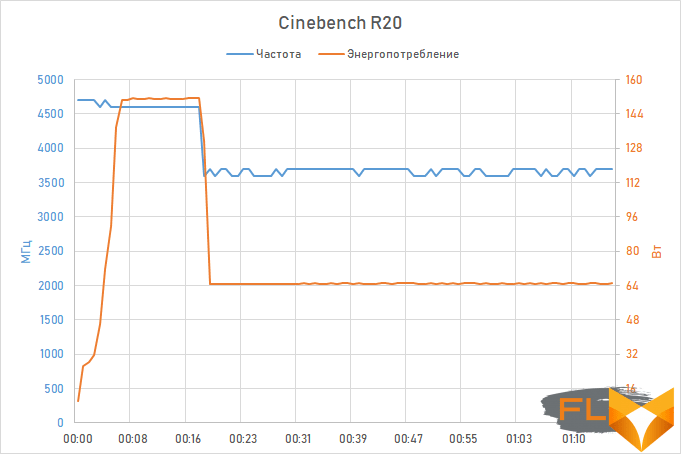
The first 20 seconds of the test Core i7-10700 runs smoothly at a maximum frequency of 4.6-4.7 GHz. At the same time, its power consumption reaches about 150 W, but this is within the rules, because it does not go beyond the PL2 border. The processor reaches 65-watt consumption only after some time, and in order to comply with the specification and not go beyond the PL1 limit, its frequency is reset to 3.6-3.7 GHz, that is, by 20-25%.
At the same time, it is very important that all the consumption limits that are described by the specification for the Core i7-10700 are actually not mandatory. Although the processor in question is not an overclocker, and its multiplier cannot be increased, it is not forbidden to change the consumption limits manually for it – the corresponding settings are available in the BIOS of almost any motherboard. As a result, users who do not need to limit power consumption can easily configure the Core i7-10700 to be guided exclusively by the turbo frequency formula, while ignoring all rating restrictions regarding heat and power consumption.

It turns out that the Core i7-10700 is the very case when you can talk about a two-in-one processor: either energy efficient, if you follow all the specifications exactly and comply with the PL1 and PL2 limits, or quite frisky if these limits are turned off. How these two entities are combined, we have displayed in the following graph, which shows the actual frequencies of the Core i7-10700 in the Cinebench R20 multi-threaded rendering test: in one case, provided that the 65-watt limit defined by the specification is enabled for the processor, and in the other case, condition with removed limits PL1 and PL2.
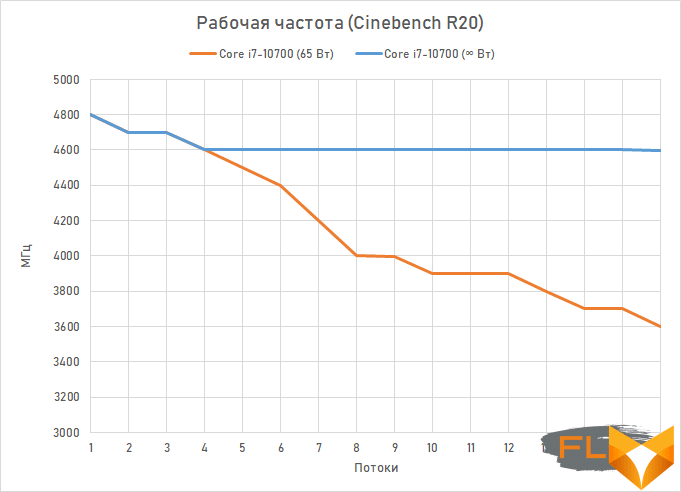
Naturally, all this affects the performance. Running without limits, the Core i7-10700 scores about 4890 points in Cinebench R20, but in the energy-efficient 65-watt state, this figure drops to 3880 points.
All this brings us to the conclusion that the Core i7-10700 is not at all similar to the Core i7-10700K, which, when the power consumption limits PL1 and PL2 are activated, loses very little in performance. This is impossible to say about the Core i7-10700: the inclusion of power consumption limits turns it into a completely different one in terms of practical CPU characteristics. Performance, as judged by Cinebench R20, is reduced by about 20%.
What picture is obtained when comparing the real consumption of the Core i7-10700 in two configurations, is shown in the following graph, which is based on measurements in Cinebench R20 with various limits on the number of active threads. This graph clearly shows that the Core i7-10700 fits into the 65 W allotted for it only with four-thread rendering.
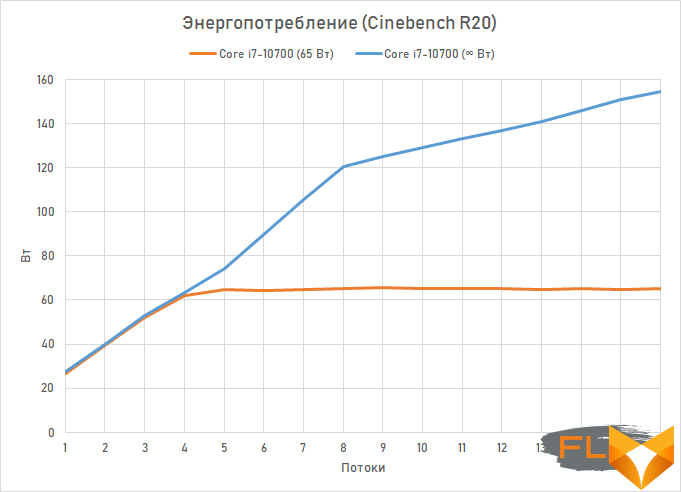
And here’s what the temperatures of this processor look like in a 65-watt-limited mode and with the power consumption restrictions removed. To remove heat in this test, a Noctua NH-U14S cooler was used.

The conclusion from these graphs is quite obvious: if the consumption limits remain in force, then the Core i7-10700 turns out to be a very economical and rather cold processor, despite the fact that we are talking about a 14-nm eight-core processor. Therefore, you should not be surprised at the bundled cooler that is included in the box with this processor. It has relatively small dimensions and is devoid of any heat pipes whatsoever. But it will certainly fit even in compact Mini-ITX form factor systems.
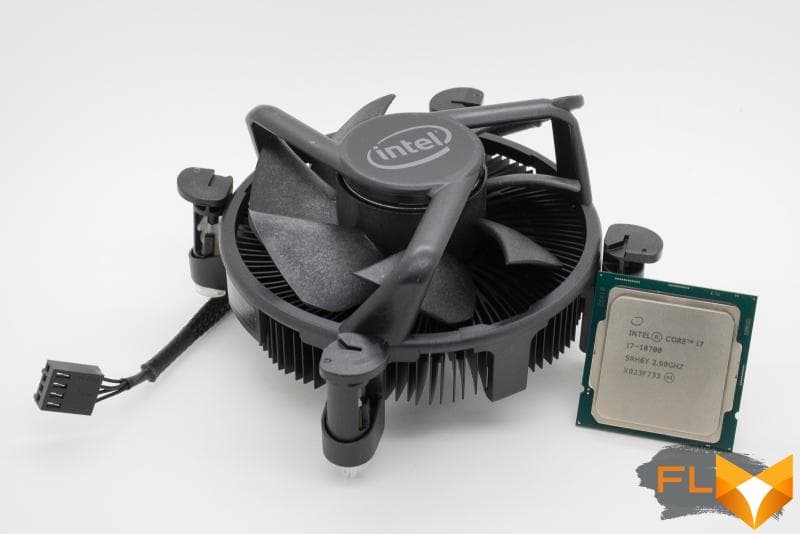
It is curious that compared to the cooling systems that Intel equipped with its processors of past generations, the cooler for the Core i7-10700 has noticeable external differences: it is anodized in black, which makes it look much more modern and noble.
⇡#Description of the test system and testing methodology
The Core i7-10700K and Core i7-10700 processors diverge in price by a significant $50. Such an amount can be a serious argument in favor of a cheaper option. Especially if we take into account its not so significant differences from the older brother in frequency, subject to the removed consumption limits.
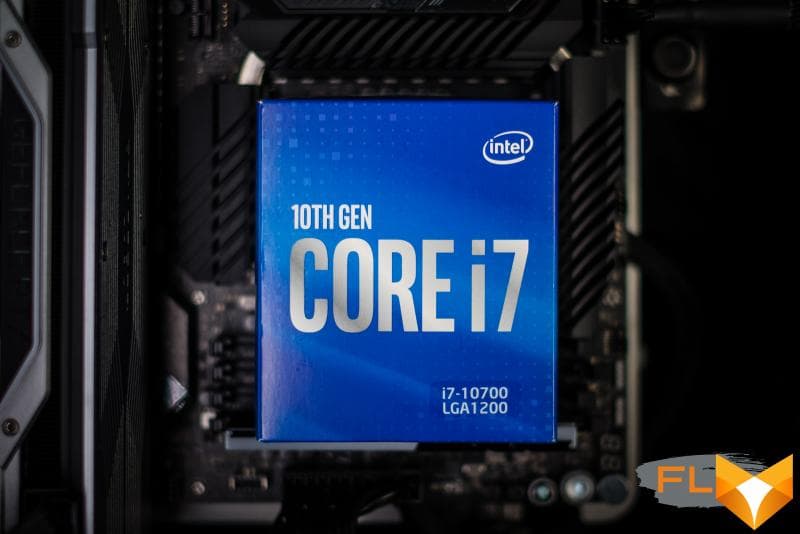
That is why we had two questions, the answer to which this test was devoted to. Question one: how much the Core i7-10700 lags behind the Core i7-10700K if all PL1 and PL2 limits are canceled for the former. And the second: what share of performance will be lost by those users who want from the Core i7-10700 not to chase an older brother, but to be economical. After all, a 65-watt eight-core processor is, in particular, a very attractive option for use in systems with small dimensions.
To answer these questions, we conducted a comparative test, which involved the following components:
- processors:
- Intel Core i7-10700K (Comet Lake, 8 cores + HT, 3.8-5.1GHz, 16MB L3);
- Intel Core i7-10700 (Comet Lake, 8 cores + HT, 2.9-4.8 GHz, 16MB L3);
- CPU cooler: Noctua NH-U14S;
- motherboard: ASUS ROG Maximus XII Hero (Wi-Fi) (LGA1200, Intel Z490);
- memory: 2 × 16 GB DDR4-3600 SDRAM, 16-19-19-39 (G.Skill TridentZ Neo F4-3600C16D-16GTZNC);
- Video card: NVIDIA GeForce RTX 2080 Ti (TU102, 1350/14000 MHz, 11 GB GDDR6 352-bit);
- disk subsystem: Samsung 970 EVO Plus 2TB (MZ-V7S2T0BW);
- Power Supply: Thermaltake Toughpower DPS G RGB 1000W Titanium (80 Plus Titanium, 1000W).
We tested the Core i7-10700K processor with the settings that motherboards set for it by default – that is, with the consumption limits canceled immediately. At the same time, the Core i7-10700 was tested in two states – an economical 65-watt and when removing the limits of PL1 and PL2.
Testing was performed on the Microsoft Windows 10 Pro (v2004) Build 19041.208 operating system using the following set of drivers:
- Intel Chipset Driver 10.1.18295.8201;
- NVIDIA GeForce 451.67 Driver.
Description of the tools used to measure computing performance:
Applications:
- 7-zip 19.00 – archiving speed testing. The time taken by the archiver to compress a directory with various files with a total volume of 3.1 GB is measured. Uses LZMA2 algorithm and maximum compression ratio.
- Adobe Photoshop 2020 21.2.1 – Graphics performance testing. The average execution time of the Puget Systems Adobe Photoshop CC Benchmark 18.10 test script, which simulates the typical processing of an image taken by a digital camera, is measured.
- Adobe Photoshop Lightroom Classic 9.3 – Performance test for batch processing of a series of RAW images. The test scenario includes post-processing and export to JPEG at a resolution of 1920 × 1080 and a maximum quality of two hundred 16-megapixel RAW images taken with a Fujifilm X-T1 digital camera.
- Adobe Premiere Pro 2020 14.3.1 – Non-linear video editing performance test. This measures the rendering time to YouTube 4K for a project containing HDV 2160p30 footage with various effects applied.
- Blender 2.83.3 – testing the speed of the final rendering in one of the popular free packages for creating three-dimensional graphics. The duration of building the final model pavillon_barcelona_v1.2 from Blender Benchmark is measured.
- Topaz Video Enhance AI v1.3.8 – performance testing in an AI-based program to improve video detail. The test uses the original video at 640×360 resolution, which is scaled up twice using the Theia-Detail model: UE,P.
- V-Ray 4.10.03 – testing the performance of a popular rendering system using the standard V-Ray Benchmark Next application;
- x265 3.2+9 10bpp – testing video transcoding speed in H.265/HEVC format. Performance is measured using a raw 2160p@24FPS AVC video file with a bitrate of approximately 42 Mbps.
Games:
- Assassin’s Creed Odyssey. Resolution 1920 × 1080: Graphics Quality = Ultra High. Resolution 2560 × 1440: Graphics Quality = Ultra High.
- Civilization VI: Gathering Storm. Resolution 1920×1080: DirectX 12, MSAA=4x, Performance Impact=Ultra, Memory Impact=Ultra. Resolution 2560 × 1440: DirectX 12, MSAA = 4x, Performance Impact = Ultra, Memory Impact = Ultra.
- Far Cry 5. 1920 × 1080 resolution: Graphics Quality = Ultra, HD Textures = On, Anti-Aliasing = TAA, Motion Blur = On. Resolution 2560 × 1440: Graphics Quality = Ultra, Anti-Aliasing = Off, Motion Blur = On.
- Hitman 2. 1920 × 1080 resolution: DirectX 12, Super Sampling = 1.0, Level of Detail = Ultra, Anti-Aliasing = FXAA, Texture Quality = High, Texture Filter = Anisotropic 16x, SSAO = On, Shadow Maps = Ultra , Shadow Resolution = High. Resolution 2560 × 1440: DirectX 12, Super Sampling = 1.0, Level of Detail = Ultra, Anti-Aliasing = FXAA, Texture Quality = High, Texture Filter = Anisotropic 16x, SSAO = On, Shadow Maps = Ultra, Shadow Resolution = High.
- Shadow of the Tomb Raider. Resolution 1920×1080: DirectX12, Preset=Highest, Anti-Aliasing=TAA. Resolution 2560 × 1440: DirectX12, Preset = Highest, Anti-Aliasing = Off.
- Total War: Three Kingdoms. Resolution 1920 × 1080: DirectX 12, Quality = Ultra, Unit Size = Extreme. Resolution 2560 × 1440: DirectX 12, Quality = Ultra, Unit Size = Extreme.
- World War Z. 1920 × 1080 resolution: DirectX11, Visual Quality Preset = Ultra. Resolution 2560 × 1440: DirectX11, Visual Quality Preset = Ultra.
In all gaming tests, the results are the average number of frames per second, as well as the 0.01-quantile (first percentile) for FPS values. The use of the 0.01-quantile instead of the minimum FPS is due to the desire to clean up the results from random bursts of performance that were provoked by reasons not directly related to the operation of the main components of the platform.
⇡#Performance in complex tests
The PCMark 10 test allows you to evaluate the performance situation when using the system in some common scenarios that ordinary users have to perform in their daily work. And as the results show, in this case, the difference between the Core i7-10700K and Core i7-10700 is almost not felt. Moreover, if the Core i7-10700 is locked inside the 65-watt limit, it will also show almost the same performance. And this means that, as long as we are not talking about some kind of resource-intensive computing load, all Intel eight-cores are approximately equivalent.



In 3DMark Time Spy the situation is different. In this benchmark, a serious processor multi-threaded load is created, and power consumption restrictions begin to play a noticeable role. In the processor subtest, the 65-watt version of the Core i7-10700 lags behind the unlimited version very noticeably. But at the same time, it is gratifying that if you do not focus on efficiency, then the performance gap between the Core i7-10700 and Core i7-10700K is reduced to a minimum.


⇡#Performance in Applications
There is nothing surprising in the fact that the 65-watt limit that applies to the Core i7-10700 results in a serious decrease in performance in resource-intensive tasks. As was shown in the first part of the article, the processor frequency due to such a limitation can be reduced up to 3.6-3.7 GHz. Therefore, in some cases, the speed of the economical version of the Core i7-10700 can be lower than that of the Core i7-10700K by a significant 25-30%. However, in fairness it should be said that this does not always happen. For example, when archiving or image processing, the gap in the results of energy-efficient and overclocking processors is not so noticeable.
In addition, we must not forget that the Core i7-10700, in addition to the energy-efficient mode, also has a “maximum turbo mode”. It does not have any consumption restrictions, and the performance is pulled up close to the level of the Core i7-10700K. The difference in results is reduced to 2-3%, which is an excellent illustration of the flexibility of the Core i7-10700, although from the specification it seems like an octa-core processor, in which efficiency is put above speed.
Rendering:


Photo processing:


Video work:


Video transcoding:


Archiving:

⇡#Gaming performance
The gaming benchmarks turned out to be the most curious part of the testing. As it turned out, under this kind of load, it almost doesn’t matter which version of the Core i7-10700 is used in the system – limited by the strict limits of the thermal package or operating in unlimited mode. But this is also natural: in modern games, the main part of the load lies on the video card, while the processor, although it is busy with calculations, they are not so intensive. Games cannot load it so much that it would consume more than 65 watts for a long time. Actually, this has been talked about for a long time: processors with eight cores for games are redundant, so the load of such a CPU in games almost never reaches 100%. In addition, modern games primarily use integer scalar operations, and they do not generate significant power consumption.
As a result, even when it comes to CPU performance at Full HD resolution, the maximum frame rate difference between the 65W Core i7-10700 and the unlimited Core i7-10700K is only a tiny 3%. And this, in turn, means that it makes little sense to purchase a processor with the letter K in the model number for gaming systems.







⇡#Energy Consumption
In power consumption tests, we primarily wanted to see how economical the Core i7-10700-based platform would be when assembled. And the tests completely satisfied our curiosity: a system with such a processor in an energy-efficient, 65-watt mode at maximum processor load consumes no more than 120 watts, which is more than half the consumption of the same platform, but with a processor that does not restrain itself by any limits energy appetites.
Along the way, another interesting detail came to light. In nominal mode, with PL1 and PL2 limits disabled, the overclocker Core i7-10700K turned out to be more economical than its weaker counterpart. At the maximum AVX load in Prime95 30.3, the difference was a noticeable 40 watts. (Recall in parentheses that the numbers shown in the diagrams are the total consumption of test systems, measured at the output from the power supply).




Thus, one should not think that for 65-watt processors, Intel chooses some special semiconductor crystals that can operate at lower voltages and therefore have better efficiency indicators. Our Core i7-10700 sample completely refutes this assumption. Rather, on the contrary, the best silicon goes to the Core i7-10700K, and the lower power consumption of the Core i7-10700 is provided by a simple clock speed adjustment.
⇡#Conclusions
The main question that we wanted to get an answer to in the study of the Core i7-10700: how much can it fall in the eyes of enthusiasts due to the fact that its nameplate heat dissipation is limited to 65 W? The answer will please many: the Core i7-10700 can be configured to make a decent octa-core processor with a good level of performance and, importantly, a significantly lower price compared to the cost of the Core i7-10700K. And if, in the context of the price, we recall the version of the Core i7-10700 without a graphics core, which is called the Core i7-10700F, then it will be especially necessary to say that this is the cheapest option among all the latest generation eight-core processors. In other words, 65-watt eight-core Intel processors are definitely not to be avoided.
The secret to getting performance close to the Core i7-10700K from the Core i7-10700 is pretty simple. Intel did not begin to limit the ability to manage consumption limits, so the TDP value of 65 W indicated for the Core i7-10700 in the specification can simply be canceled. This allows you to bring the operating frequencies of such a processor to a level close to the frequencies of the Core i7-10700K. The difference in this case will be only 100-300 MHz, which means a very small gap in performance, especially if we talk about the gaming aspect – the frame rate in games. The only thing to keep in mind is that, despite the non-overclocking nature of the Core i7-10700, it is strongly recommended to use it in boards based on the Z490 logic set, since only with them can it be equipped with fast RAM, not DDR4-2933.

As for the efficiency of the Core i7-10700, then this side of it looks very good. The processor can really fit into the 65-watt range, to comply with which it will dynamically drop the frequency as the load increases, adjusting to the set limit. Such a scenario is far from always interesting, but in some cases it is still useful: thanks to it, the Core i7-10700 becomes an eight-core processor that can fit into cold, quiet and economical systems without any problems. And although the performance loss relative to the Core i7-10700K in peak cases of resource-intensive computing load (like rendering or video transcoding) can reach 25-30%, in most common tasks and, most importantly, in games, the difference in performance is not too significant. . For example, according to our tests, the gap between the 65-watt Core i7-10700 and the Core i7-10700K in terms of frame rate in games in Full HD resolution did not exceed 3%, which indicates the ability to use the Core i7-10700 in compact gaming computers, such as Mini-ITX.
Thus, the main conclusion that can be drawn from the results should be formulated as follows: among the eight-core Intel processors of the Comet Lake generation, not only the overclocker Core i7-10700K is of interest to enthusiasts, but also its younger brother without the letter K in the name – Core i7- 10700. It’s cheaper, but surprisingly flexible. On the one hand, this is an economical CPU, well suited for small format systems, and on the other hand, when consumption limits are turned off, it miraculously turns into something like a Core i7-10700K, except without overclocking capabilities. In other words, the “two in one” metaphor is just about the Core i7-10700.
FAQ Intel core i7-10700 review
How does the AMD Ryzen 7 compare to the Intel Core i7 in terms of power limit and performance?
The AMD Ryzen 7 generally offers a better power-to-performance ratio compared to the Intel Core i7, with a lower power draw and efficient performance, especially in multi-threaded tasks.
What is the spec difference between the Ryzen 5 and the Core i9 in terms of core count?
The Ryzen 5 processors typically have fewer cores compared to the Core i9 family. For instance, Ryzen 5s like the 3600 have 6 cores, while Core i9s often have 8 or more cores, delivering higher multi-threaded performance.
How does the Ryzen 7 3700X’s performance compare to the Intel Core i7-10700K?
The Ryzen 7 3700X, with its 65 W TDP, offers efficient performance and is generally more power-efficient compared to the Intel Core i7-10700K, which has a higher TDP of 125W but may provide a better performance boost in single-threaded tasks.
Can you overclock the Intel Core i7-10700 processor, and how does it affect power usage?
Yes, you can overclock the Intel Core i7-10700 processor, especially when using a Z490 motherboard. Overclocking increases power usage and requires a good cooling solution to manage the additional heat generated.
What are the key features of the Ryzen 7 3700X according to AnandTech’s full review?
AnandTech’s full review of the Ryzen 7 3700X highlights its efficient performance, 65 W TDP rating, strong multi-threaded capabilities, and being a value-for-money option in AMD’s processor lineup.
What is the turbo boost max 3.0 feature in the Intel Core i7-10700, as mentioned in the review?
Turbo Boost Max 3.0 in the Intel Core i7-10700 is a feature that increases the CPU’s clock speed beyond its base frequency for a short period to provide a performance boost, especially in single-threaded applications.
How do Ryzen processors, like the Ryzen 5 and Ryzen 7, handle power draw compared to Intel’s Comet Lake architecture CPUs?
Ryzen processors like the Ryzen 5 and Ryzen 7 typically have a more efficient power draw compared to Intel’s Comet Lake architecture CPUs, offering similar or better performance with less energy consumption.
What is the TDP rating of the Ryzen 7 3700X, and how does it compare to Intel CPUs like the Core i7-10700K?
The TDP rating of the Ryzen 7 3700X is 65W, which is lower compared to the Intel Core i7-10700K’s TDP of 125W, making the Ryzen 7 more power-efficient.
Does the Ryzen 7 3700X support dual-channel memory and XMP profiles for higher boost frequencies?
Yes, the Ryzen 7 3700X supports dual-channel memory and can utilize XMP profiles to achieve higher boost frequencies, enhancing its performance especially in memory-intensive applications.
In terms of full load power consumption, how do AMD’s Ryzen processors like the 3700X compare to Intel’s 10700K?
Under full load, AMD’s Ryzen processors like the 3700X generally consume less power compared to Intel’s 10700K. The Ryzen 3700X maintains efficiency with its 65 W TDP, while the 10700K can draw significantly more power, often exceeding its 125W TDP under heavy loads.
What is the significance of a 4.8 GHz clock speed in a CPU like the Core i7-10700?
A 4.8 GHz clock speed in a CPU like the Core i7-10700 indicates its maximum turbo frequency, enhancing its single-threaded performance for demanding applications and tasks.
How does the GPU impact the overall performance of a system with a Core i5 processor?
The GPU significantly impacts a system’s overall performance, especially in graphics-intensive tasks. In a system with a Core i5 processor, a powerful GPU can complement the CPU for gaming, video editing, and other GPU-reliant activities.
What are the benefits of using an SSD in a desktop PC with a Core i7 processor?
Using an SSD in a desktop PC with a Core i7 processor offers faster data access and boot times, significantly improving system responsiveness and application loading times compared to traditional HDDs.
According to AnandTech’s review, how does the Core i7-10700 perform in CPU benchmarks?
AnandTech’s review of the Core i7-10700 shows that it performs well in CPU benchmarks, offering solid all-core performance, making it a strong competitor in its category for both gaming and productivity.
What features in the Core i7 family contribute to better performance in multitasking?
Features in the Core i7 family that contribute to better performance in multitasking include hyperthreading, which allows for more efficient processing of multiple tasks, and a higher number of cores and threads.
How does Thermal Velocity Boost impact the performance of the Core i7-10700?
Thermal Velocity Boost in the Core i7-10700 allows the processor to temporarily exceed its base clock speed under certain thermal conditions, providing a performance boost, especially in short bursts of demanding tasks.
What considerations should MSI and other motherboard manufacturers keep in mind for CPUs like the 3800X and Core i7-10700?
MSI and other motherboard manufacturers should ensure compatibility with these CPUs’ socket types (e.g., LGA115x for Intel), support for their power requirements, and enable features like dual channel memory and overclocking capabilities.
How does hyperthreading in CPUs like the Core i7-10700 enhance single-threaded performance?
Hyperthreading in CPUs like the Core i7-10700 primarily enhances multi-threaded performance by allowing each core to handle two processing threads simultaneously, though it can also benefit single-threaded performance through improved efficiency.
What is the role of memory running at Intel recommended values in a desktop PC?
Memory running at Intel recommended values ensures stability and optimal performance, especially when paired with Intel CPUs. It ensures that the memory is running at speeds and timings that are compatible with the CPU’s specifications.
What are the power considerations for a 14nm desktop PC CPU like the Core i7-10700 under full load?
For a 14nm desktop PC CPU like the Core i7-10700, power considerations under full load include ensuring a power supply that can handle the CPU’s power draw, which can exceed its TDP rating (e.g., 200W) during intense tasks, and effective cooling to maintain performance.


